| Heath Parasol | |
|---|---|
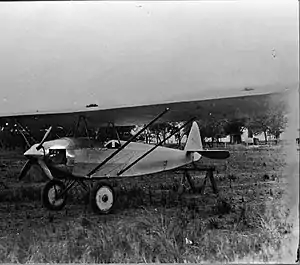 | |
| Parasol, photographed in 1935.[Notes 1] | |
| Role | Home-built aircraft |
| National origin | United States |
| Manufacturer | Heath |
| Designer | Edward Bayard Heath |
| First flight | 1926 |
| Introduction | Parasol (1926); 1927 (Super Parasol); 1930 (V Parasol; 1931 (LN Parasol) |
| Primary user | Recreational flyers |
The Heath Parasol is an American single or two seat,[1] open-cockpit, parasol winged, homebuilt monoplane.
Design and development
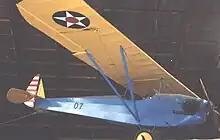
.jpg.webp)
In 1926, Edward Bayard Heath, a successful American air racer and the owner of an aircraft parts supply business, built the first example of the Heath Parasol, a small, single seat parasol winged airplane using surplus wings from a Thomas-Morse S-4, a World War One fighter trainer, mounted above a steel-tube structure fuselage and powered by a Henderson four-cylinder motorcycle engine.[1] This was the prototype for a series of single and two-seat recreational craft that utilized the Clark Y airfoil. In 1929 Modern Mechanix magazine published the plans in a series[2] and the plans were reprinted in their "1930 Flying & Gliding Manual," which in turn has been reprinted periodically by the EAA (Experimental Aircraft Association).[1]
Although Heath died in 1931 his Parasol designs remained extremely popular, being economical to build and operate as well as easy to fly. Subsequently, the Heath Company of St. Joseph / Benton Harbor Michigan sold nearly 1,000 kits on an installment basis.[3] Fewer than 50 aircraft were factory built, but several hundred were completed and flown by homebuilders during the Great Depression. Heath is remembered today for having helped pioneer the homebuilt aircraft industry and for having introduced the kit concept of packaging the materials needed to build an aircraft.
When it ceased producing aircraft kits to concentrate on electronics (Heathkit), the Heath Company sold the ATC (CAA Aircraft Type Certificate) for the LNA-40 (ATC-487) [4] to the EAA who continued to sell original plans to potential homebuilders.[1]
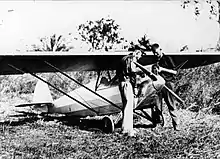
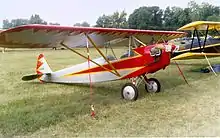
Except for the prototype, the wings consist of two solid spruce spars, built up wooden ribs, compression struts, and internal drag and anti-drag bracing. The Parasol's empennage is built of wood, and externally braced. Depending on the model, the fuselage was built of wood, bolted steel tube, or welded steel tube.[3] Wing, empennage, and fuselage are fabric covered. Two five gallon fuel tanks are typically installed at the root end of each wing, the fuel being gravity fed, sometimes to a small collector tank behind the firewall. The only tools necessary to assemble one of the Parasol kits were a pair of small pliers, screwdriver, hacksaw (with plenty of blades), hammer, small hand drill, chisel, center punch, file and drill.
A variety of powerplants could be fitted, including the factory-supplied converted Henderson Motorcycle engine (viz. 25 hp (19 kW) Heath-Henderson B-4). Post-war, the VW boxer engine was used as well.[1]
Production of an early version was undertaken as early as 1931, in Australia, by the Adcock-Heath Company.
Variants
Home building encourages local variations that blur type definitions for non-certificated versions.
- Prototype
- Used the 24 ft 0 in (7.32 m), wing from a Thomas-Morse S-4C "Tommy."
- CA-1 Parasol
- Wingspan of 24 ft 0 in (7.32 m), with square tips. Parallel wing struts. First built 1928. Not Certificated (nor required to be). One seat. 260 pound empty weight. Heath B-4 engine, 27 hp at 2800 rpm.[1][5]
- CA-1A Super Parasol
- Wingspan of 25 ft 0 in (7.62 m), with rounded tips. Parallel wing struts. First built 1929. Not Certificated (nor required to be). One seat. 260 pound empty weight. Heath B-4 engine, 27 hp at 2800 rpm.[1][6]
- V-Parasol
- Span 25 ft 0 in (7.62 m), various more powerful engines and V-form wing struts.[7]
- LNB-4 Parasol
- Wing span increased to 31 ft 5 in (9.58 m). N-form struts. One or two seat. 450 pound empty weight. Heath B-4 engine, 25 hp at 2800 rpm. Certificated (CAA, ATC-456)[4] June 3, 1932.
- LNA-40 Parasol
- Wingspan of 31 ft 5 in (9.58 m), V-form struts. One or two seats. 465 pound empty weight. Door moved to opposite side of fuselage to accommodate hand-propping the clockwise turning 37 hp (28 kW) (at 2550 rpm) Continental A40 powerplant. First built 1932. CAA type certificated (ATC-457) June 3, 1932.[4][1][8]
Surviving aircraft
- LNB-4 on static display at the New England Air Museum in Windsor Locks, Connecticut.[9]
- An example is on static display at the Museum of Flight in Seattle, Washington.[10]
- LNB-4 is on static display at the EAA Aviation Museum in Oshkosh, Wisconsin.[11]
- LNA-40 is on static display at the Mid-Atlantic Air Museum in Reading, Pennsylvania.[12]
- An example is on display at the Western North Carolina Air Museum in Hendersonville, North Carolina.[13]
- LNA-40 is on static display at the Old Rhinebeck Aerodrome in Red Hook, New York.[14]
- An example is in storage at the Golden Age Air Museum in Bethel, Pennsylvania.[15]
- An example is on display at the Western Antique Aeroplane and Automobile Museum in Hood River, Oregon.[16]
- LNB-4 on static display at the Tri-State Warbird Museum in Batavia, Ohio.[17]
- An example is on display at the Shannon Air Museum in Fredericksburg, Virginia.[18][19]
- An example is on display at the Moorabbin Air Museum in Melbourne, Victoria.[20]
- An example is on display at the Eagles Mere Air Museum in Laporte, Pennsylvania.[21]
Specifications (Super Parasol)
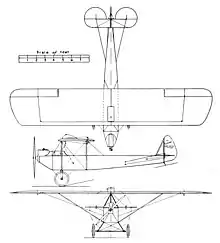
Data from Aviation[22]
General characteristics
- Crew: 1
- Length: 17 ft 0 in (5.18 m)
- Wingspan: 25 ft 0 in (7.62 m)
- Height: 4 ft 6 in (1.37 m)
- Wing area: 110 sq ft (10 m2)
- Empty weight: 280 lb (127 kg)
- Gross weight: 580 lb (263 kg)
- Fuel capacity: 9 US gal (7.5 imp gal; 34 L)
- Powerplant: 1 × Heath , 27 hp (20 kW)
Performance
- Maximum speed: 70 mph (110 km/h, 61 kn)
- Cruise speed: 65 mph (105 km/h, 56 kn)
- Stall speed: 32 mph (51 km/h, 28 kn)
- Range: 270 mi (430 km, 230 nmi)
- Service ceiling: 12,500 ft (3,800 m)
- Rate of climb: 500 ft/min (2.5 m/s)
See also
- Heathkit descendant company, maker of electronic kits
Aircraft of comparable role, configuration, and era
- Dormoy Bathtub
- Aerotique Parasol
- Fisher FP-505 Skeeter
- Loehle Sport Parasol
- Pietenpol Air Camper
- Pop's Props Cloudster
- Pop's Props Zing
- Powell P-70 Acey Deucy
- RagWing RW5 Heath Replica
Notes
- ↑ Built by Methodist missionary Harold Shepherdson on Elcho Island in the remote Arnham Land region of northern Australia. It was built from an imported kit and fitted with DH.60 Moth main wheels and a 34 hp two-cylinder Bristol Cherub. The Reverend Shepherdson completed a number of ground runs in his Parasol before severely damaging it by hitting a tree stump. Its remains are now in the collection of the Australian Aviation Heritage Centre in Darwin.
References
Notes
- 1 2 3 4 5 6 7 8 Bowers, Peter M. (January 1982). "The Heath Parasol". AOPA Pilot. pp. 69–71.
- ↑ "Modern Mechanics". Archived from the original on 2008-06-26. Retrieved 2008-06-07.
- 1 2 "Home". wisconsinhistory.org.
- 1 2 3 Federal Record: ATC 487, June 3, 1932
- ↑ McLaughlin, George F. (March 1927). "The Heath Parasol Sport". Aero Digest. Vol. 10, no. 3. p. 184. Retrieved March 13, 2021.
- ↑ "The Heath Super Parasol". Aero Digest. Vol. 14, no. 6. June 1929. p. 98. Retrieved March 13, 2021.
- ↑ Heath aircraft
- ↑ Air Progress Sport Aircraft: 70. Winter 1969.
{{cite journal}}: Missing or empty|title=(help) - ↑ "Heath LNB-4 "Parasol"". New England Air Museum. Archived from the original on 5 August 2020. Retrieved 23 January 2023.
- ↑ "Heath Parasol". Museum of Flight. Retrieved 23 January 2023.
- ↑ "Heath LNB-4 Parasol – N953M". AirVenture Museum. Archived from the original on 27 May 2007. Retrieved 23 January 2023.
- ↑ "Heath LNA-40 "Parasol"". Mid-Atlantic Air Museum. Retrieved 23 January 2023.
- ↑ Lilley, Joseph W. "1928 Heath Parasol". Western North Carolina Air Museum. Retrieved 23 January 2023.
- ↑ "Heath Parasol LNA-40". Old Rhinebeck Aerodrome. Retrieved 23 January 2023.
- ↑ "Museum Collection". Golden Age Air Museum. Retrieved 23 January 2023.
- ↑ "Airplanes by Year". Western Antique Aeroplane & Automobile Museum. Retrieved 23 January 2023.
- ↑ "Airframe Dossier - Heath Super Parasol, c/n 154, c/r N752Y". Aerial Visuals. Retrieved 23 January 2023.
- ↑ "Airframe Dossier - Heath Super Parasol, c/n 31919, c/r N1926". Aerial Visuals. Retrieved 23 January 2023.
- ↑ "FAA Registry [N1926]". Federal Aviation Administration. U.S. Department of Transportation. Retrieved 23 January 2023.
- ↑ "McKenna Heath Parasol". Moorabbin Air Museum. Retrieved 23 January 2023.
- ↑ "Antique Airplanes & Vintage Engines on Display". Eagles Mere Air Museum. Retrieved 23 January 2023.
- ↑ "Manufacturer's Specifications on American Commercial Airplanes as Compiled by Aviation". Aviation. January 18, 1930. pp. inside front cover.
Bibliography
Further reading
- Bowers, Peter M. (January 1982). "The Heath Parasol" (PDF). AOPA Pilot. pp. 69–71. Retrieved 23 January 2023.
- Heath, E. B. (January 1931). "How to Build the Heath Parasol: Part II, The Wing Structur and Spars". Popular Aviation. pp. 33–34, 54, 63. Retrieved 20 January 2023.
- Sport Flying Quarterly. Vol. 9, no. 7. 1975. pp. 54–63.
{{cite magazine}}: Missing or empty|title=(help)